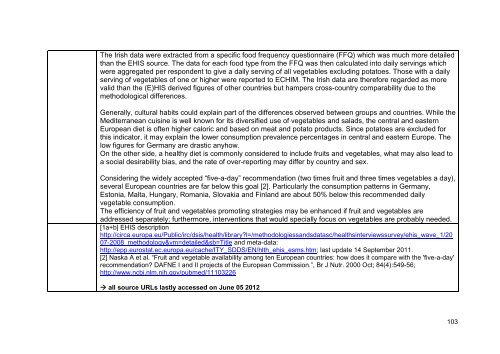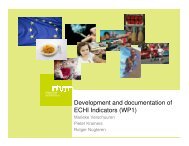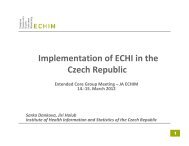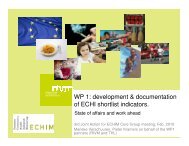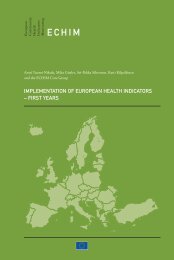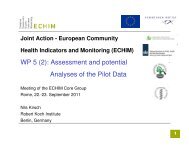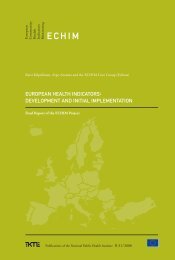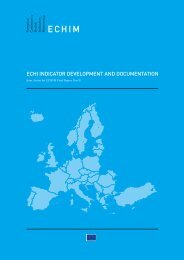Final Report Part III ECHIM Pilot Data Collection Analyses and Dissemination
Part III: ECHIM Pilot Data Collection, Analyses and Dissemination
Part III: ECHIM Pilot Data Collection, Analyses and Dissemination
- No tags were found...
Create successful ePaper yourself
Turn your PDF publications into a flip-book with our unique Google optimized e-Paper software.
The Irish data were extracted from a specific food frequency questionnaire (FFQ) which was much more detailed<br />
than the EHIS source. The data for each food type from the FFQ was then calculated into daily servings which<br />
were aggregated per respondent to give a daily serving of all vegetables excluding potatoes. Those with a daily<br />
serving of vegetables of one or higher were reported to <strong>ECHIM</strong>. The Irish data are therefore regarded as more<br />
valid than the (E)HIS derived figures of other countries but hampers cross-country comparability due to the<br />
methodological differences.<br />
Generally, cultural habits could explain part of the differences observed between groups <strong>and</strong> countries. While the<br />
Mediterranean cuisine is well known for its diversified use of vegetables <strong>and</strong> salads, the central <strong>and</strong> eastern<br />
European diet is often higher caloric <strong>and</strong> based on meat <strong>and</strong> potato products. Since potatoes are excluded for<br />
this indicator, it may explain the lower consumption prevalence percentages in central <strong>and</strong> eastern Europe. The<br />
low figures for Germany are drastic anyhow.<br />
On the other side, a healthy diet is commonly considered to include fruits <strong>and</strong> vegetables, what may also lead to<br />
a social desirability bias, <strong>and</strong> the rate of over-reporting may differ by country <strong>and</strong> sex.<br />
Considering the widely accepted “five-a-day” recommendation (two times fruit <strong>and</strong> three times vegetables a day),<br />
several European countries are far below this goal [2]. <strong>Part</strong>icularly the consumption patterns in Germany,<br />
Estonia, Malta, Hungary, Romania, Slovakia <strong>and</strong> Finl<strong>and</strong> are about 50% below this recommended daily<br />
vegetable consumption.<br />
The efficiency of fruit <strong>and</strong> vegetables promoting strategies may be enhanced if fruit <strong>and</strong> vegetables are<br />
addressed separately; furthermore, interventions that would specially focus on vegetables are probably needed.<br />
[1a+b] EHIS description<br />
http://circa.europa.eu/Public/irc/dsis/health/library?l=/methodologiess<strong>and</strong>sdatasc/healthsinterviewssurvey/ehis_wave_1/20<br />
07-2008_methodology&vm=detailed&sb=Title <strong>and</strong> meta-data:<br />
http://epp.eurostat.ec.europa.eu/cache/ITY_SDDS/EN/hlth_ehis_esms.htm; last update 14 September 2011.<br />
[2] Naska A et al. “Fruit <strong>and</strong> vegetable availability among ten European countries: how does it compare with the 'five-a-day'<br />
recommendation? DAFNE I <strong>and</strong> II projects of the European Commission.”, Br J Nutr. 2000 Oct; 84(4):549-56;<br />
http://www.ncbi.nlm.nih.gov/pubmed/11103226<br />
all source URLs lastly accessed on June 05 2012<br />
103


